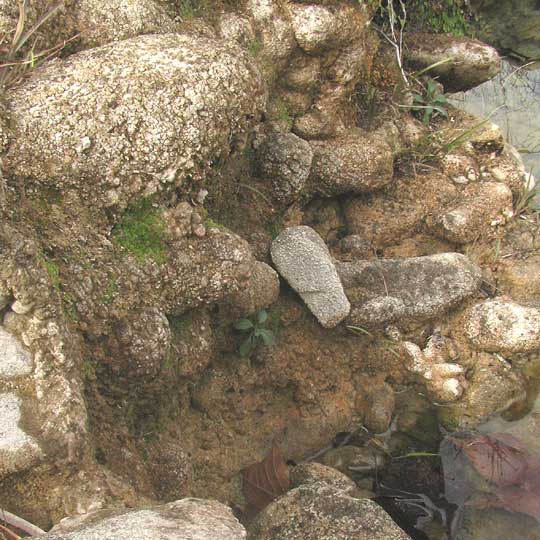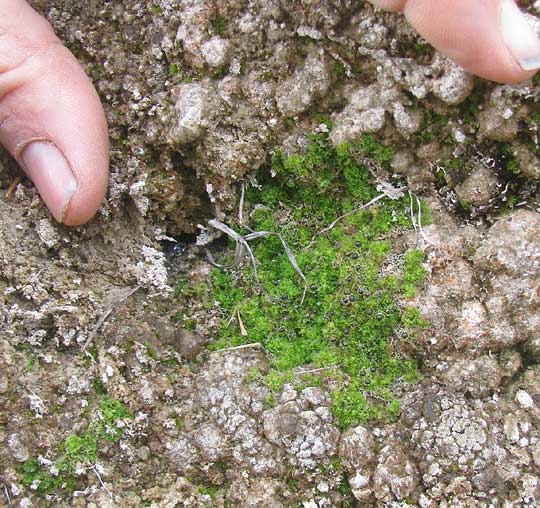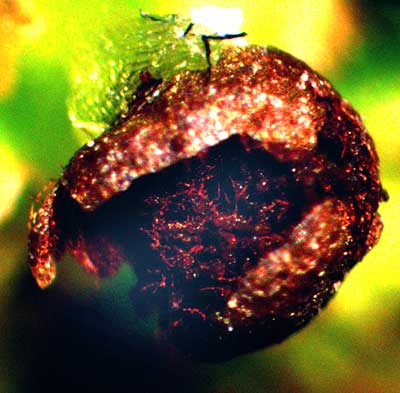Excerpts from Jim Conrad's
Naturalist Newsletter

from the January 19, 2014 Newsletter issued from the Frio Canyon Nature Education Center in the valley of the Dry Frio River in northern Uvalde County, southwestern Texas, on the southern border of the Edwards Plateau; elevation ~1750m (~5750 ft); N29.62°, W99.86°; USA
FOSSOMBRONIA LIVERWORT
Unable to find much new in our wintry landscape I was working down the Dry Frio's mostly dry streambed looking for mosses in sheltered spots near water. The boulders and cobblestones heaped up there by a long-ago flashflood were coated with thick, drying, flaking marl, or muddy lime. This time last year water cascaded over the same stones, but we've been having a drought since then. In this fairly forlorn, unpromising-looking spot suddenly something caught my eye. Maybe you can see it, too, in the picture below:

To get oriented in that picture, notice the shiny water surfaces at the right. The large rock in the upper, left corner is maybe 2½ feet across (75cm). Here and there tufts of grass are sprouting. But what I wanted to see closer was the faint, green smudge at the base of that boulder at the top, left. Below, you can see what the smudge looked like closer up:

At first I thought it was a moss colony getting started and I looked for capsules, but there were none. However, can you see the tiny, dark, spherical items scattered throughout the colony? A closer look is at the top of this page.
This was something I'd never seen in my life. Notice that toward the top, center of the picture one of the black, spherical items stands atop a pale stem issuing from the cuplike structure below it. Apparently the black things are sporangia, but no moss has sporangia like that. I collected one plant. Back in Juniper House, the dissecting scope provided an even closer look at a mature sporangium, shown below:

The sporangium's near side has fallen away to reveal a spongy interior. A rippled daub of clear, gelatinous matter adheres to the sporangium's top and I have no idea how to interpret that.
To identify this discovery I had to begin at the beginning. First, with a sporangium on a stalk arising from a green, photosynthesizing plant body, it just had to be a bryophyte. The three kinds of bryophytes are mosses, liverworts and hornworts. The spherical sporangium is unlike any moss sporangium I've seen, and hornwort sporangia are like tiny, slender, sharp-tipped fingers, so that left the liverworts. Doing an image search on the keywords "liverwort sporangia," before long a picture turned up of something similar to what's in our pictures. It was a liverwort of the genus Fossombronia.
The Flora of North America checklist includes eleven Fossombronia species for North America. Of these, only two appear to have been observed in Texas: F. texana and F. zygospora. The latter was collected only once on red, loamy soil very different from our Dry Frio habitat. Fossombronia texana, however, occurs on limestone. In fact, the only illustration I could find of Fossombronia texana, matching perfectly our Dry Frio plants, and appearing at the centexnaturalist.com website, describes its Texas habitat as "... limey clay banks and near waterfalls on a small stream running through limestone," which fits our location about perfectly.
So, apparently what we have is FOSSOMBRONIA TEXANA. A plant named Fossombronia americana was collected near Puebla, Mexico, and later determined to be the same as Fossombronia texana, so maybe the species occurs not only in Texas but also Mexico. Whatever its distribution, it's very rarely encountered and not much is known about it.
To identify Fossombronia liverworts to species level, microscopic examination of the spores normally is needed. Vegetative parts vary greatly, but the size and surface ornamentation patterns of the spores are distinctive.
This just may be the most exciting discovery I've made since being here!
Liverworts, by the way, are primitive, fascinating plants. If you need an introduction to them, Wikipedia's liverwort page is fairly good, though at this time it's confusingly entitled "Marchantiophyta." It's at https://en.wikipedia.org/wiki/Marchantiophyta.
from the April 27, 2014 Newsletter issued from the Frio Canyon Nature Education Center in the valley of the Dry Frio River in northern Uvalde County, southwestern Texas, on the southern border of the Edwards Plateau; elevation ~1750m (~5750 ft); N29.62°, W99.86°; USA
FOSSOMBRONIA LIVERWORT UPDATE
I've been watching our Fossombronia, and in the meantime have discovered other populations also on boulders in the Dry Frio, all covered with dried, limy muck. The liverworts' main leaves appear to have died back but now bud-like green
"sprouts" are appearing. Also, the remarkable spherical spore capsules atop their white stems have for the most part disintegrated. You can see their current condition below:
